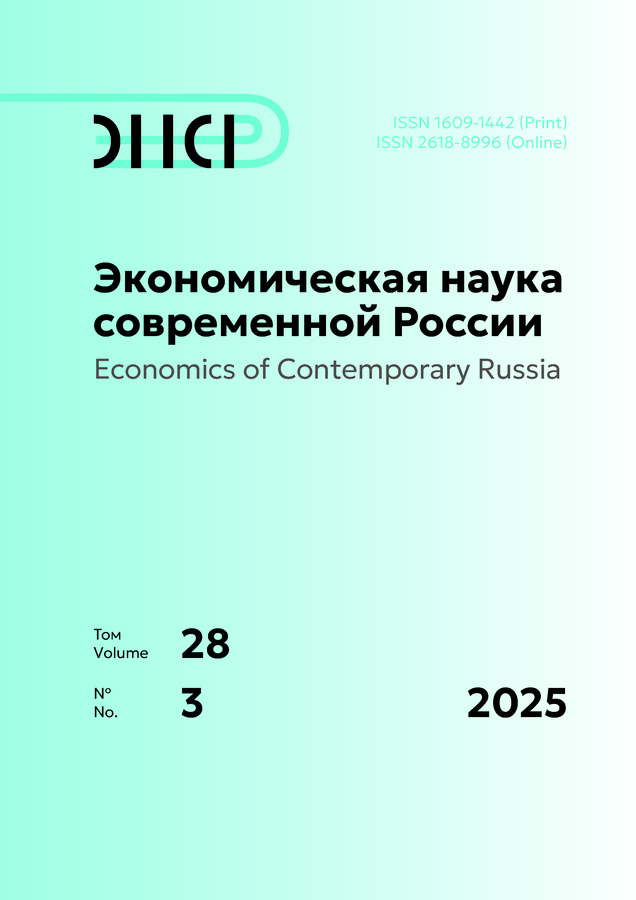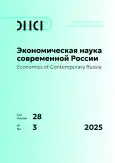Метод корректировки неоднородности панельных данных в моделях сложных экономических систем
- Авторы: Бабешко Л.О.1
-
Учреждения:
- Институт цифровых технологий, Финансовый университет при Правительстве РФ
- Выпуск: Том 28, № 3 (2025)
- Страницы: 26-36
- Раздел: Актуальные проблемы экономической теории
- URL: https://journal-vniispk.ru/1609-1442/article/view/333353
- DOI: https://doi.org/10.33293/1609-1442-2025-28(3)-26-36
- EDN: https://elibrary.ru/CJANID
- ID: 333353
Цитировать
Полный текст
Аннотация
Статья посвящена построению моделей для панельных данных, учитывающих влияние качественных признаков на эндогенную переменную. Эконометрическим инструментом, формализующим влияние качественных признаков, являются фиктивные переменные. Необходимость включения фиктивных переменных в эконометрические модели в последнее время диктуется структурными изменениями в экономике ряда стран, вызванными беспрецедентными западными санкциями и изменениями, связанными с пандемией. Цель исследования - построить и апробировать модели товарооборота России со странами БРИКС в рамках моделей для панельных данных, учитывающих влияние качественных (постоянных во времени) признаков на эндогенную переменную с применением метода декомпозиции фиксированных эффектов (FEVD). Метод FEVD обеспечивает более гибкую спецификацию модели, совмещая достоинства моделей с фиксированными и случайными эффектами, но не опираясь на жесткие допущения о некоррелированности индивидуальных эффектов и регрессоров, характерных для модели случайных эффектов. Это совмещение расширяет возможности панельного анализа в эконометрике и позволяет более точно моделировать влияние качественных факторов на эндогенную переменную. Задача исследования включает: построение эконометрических моделей для панельных данных для прогнозирования объемов товарооборота России со странами БРИКС; проведение спецификационных тестов этих моделей; повышение точности прогнозов в рамках метода FEVD, алгебраическую и эмпирическую проверку свойств оценок параметров метода. В результате проведена адаптация метода FEVD к специфике экономик стран БРИКС в условиях современных экономических вызовов. В качестве эмпирической базы использованы сбалансированные панельные данные по пяти странам БРИКС (Бразилия, Россия, Индия, Китай, ЮАР) за период 2000-2020 гг. Особое внимание уделено анализу воздействия макроэкономических показателей (ВВП, курс доллара, цена на нефть, пандемийный шок и др.) на товарооборот России со странами БРИКС. Метод FEVD позволил повысить точность результатов оценивания по сравнению с традиционной моделью с фиксированными эффектами. Исследование вносит вклад в эмпирическую базу оценки моделей с фиксированными эффектами методом FEVD.
Об авторах
Л. О. Бабешко
Институт цифровых технологий, Финансовый университет при Правительстве РФ
Автор, ответственный за переписку.
Email: LBabeshko@fa.ru
ORCID iD: 0000-0002-7692-3894
SPIN-код: 7233-2760
доктор экономических наук, профессор, главный научный сотрудник Москва
Список литературы
- Абакумова Ю. Г., Павловская С. В. (2010). Матричное моделирование двусторонних торговых отношений стран // Векторы внешнеэкономической деятельности / ред. совет: В. М. Руденков и др. Минск: Институт экономики НАН Беларуси. С. 71-382.
- Бабешко Л. О., Бывшев В. А. (2025). Анализ стабильности модели прогнозирования объемов взаимной торговли России с партнерами БРИКС // Финансы: теория и практика. Т. 29. No 4. С. 129-145. doi: 10.26794/2587-5671-2025-29-4-1902-01
- Бабешко Л. О., Михалева М. Ю. (2025). Количественная оценка влияния объемов выданных кредитов на уровень прибыли коммерческих банков в России // Фундаментальные исследования. No 2. С. 23-35.
- Бабешко Л. О., Харитонов Д. А. (2024). Проверка адекватности модели товарооборота России и Китая методом Салкевера // Мягкие измерения и вычисления. Т. 84. No 11. С. 103-111. doi: 10.36871/2618-9976.2024.11.008
- Балыгин М. Г., Шайлиева М. М., Цыпин А. П. (2020). Статистический анализ экономического развития стран БРИКС // Статистика и экономика. No 17 (2). С. 18-28.
- Бывшев В. А. (2022). Прогнозирование объемов взаимной торговли между странами на базе макроэкономических показателей. Отчет о НИР в рамках ВТСК (Временный творческий студенческий коллектив). No 17.
- Картаев Ф. С. (2019). Введение в эконометрику: учебник. М.: МГУ. 472 с.
- Радионова М. В., Кулакова А. М. (2015). Моделирование взаимной торговли товарами между странами (на примере государств - членов ЕАЭС) в отраслевом разрезе // Финансовая аналитика: проблемы и решения. No 34. С. 41-54.
- Эконометрика (2025). Эконометрика: учебник для вузов / под ред. И. И. Елисеевой. М.: Юрайт. 449 с.
Дополнительные файлы









